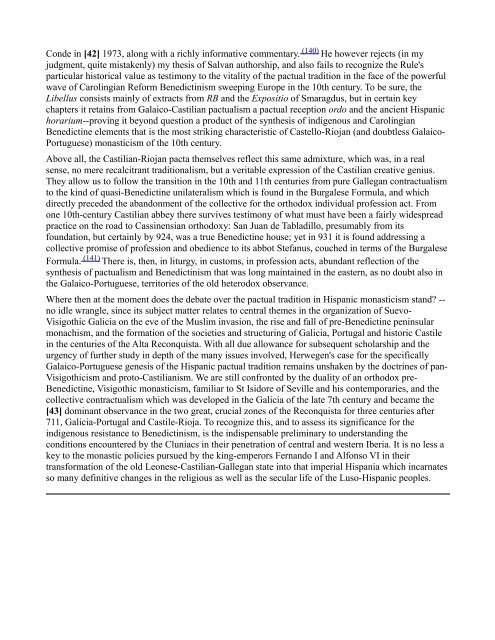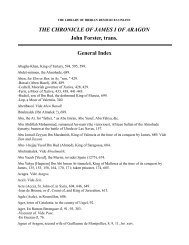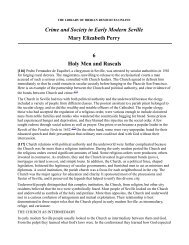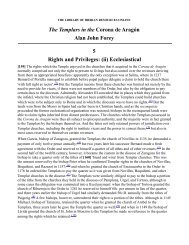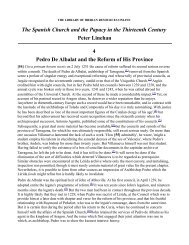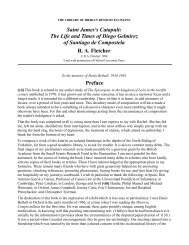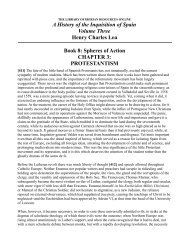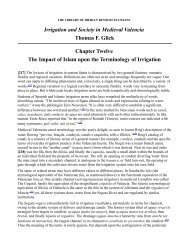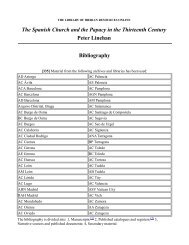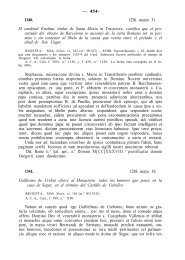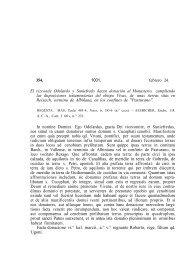The Pactual Tradition in Hispanic Monasticism - The Library of ...
The Pactual Tradition in Hispanic Monasticism - The Library of ...
The Pactual Tradition in Hispanic Monasticism - The Library of ...
Create successful ePaper yourself
Turn your PDF publications into a flip-book with our unique Google optimized e-Paper software.
Conde <strong>in</strong> [42] 1973, along with a richly <strong>in</strong>formative commentary. (140) He however rejects (<strong>in</strong> my<br />
judgment, quite mistakenly) my thesis <strong>of</strong> Salvan authorship, and also fails to recognize the Rule's<br />
particular historical value as testimony to the vitality <strong>of</strong> the pactual tradition <strong>in</strong> the face <strong>of</strong> the powerful<br />
wave <strong>of</strong> Carol<strong>in</strong>gian Reform Benedict<strong>in</strong>ism sweep<strong>in</strong>g Europe <strong>in</strong> the 10th century. To be sure, the<br />
Libellus consists ma<strong>in</strong>ly <strong>of</strong> extracts from RB and the Expositio <strong>of</strong> Smaragdus, but <strong>in</strong> certa<strong>in</strong> key<br />
chapters it reta<strong>in</strong>s from Galaico-Castilian pactualism a pactual reception ordo and the ancient <strong>Hispanic</strong><br />
horarium--prov<strong>in</strong>g it beyond question a product <strong>of</strong> the synthesis <strong>of</strong> <strong>in</strong>digenous and Carol<strong>in</strong>gian<br />
Benedict<strong>in</strong>e elements that is the most strik<strong>in</strong>g characteristic <strong>of</strong> Castello-Riojan (and doubtless Galaico-<br />
Portuguese) monasticism <strong>of</strong> the 10th century.<br />
Above all, the Castilian-Riojan pacta themselves reflect this same admixture, which was, <strong>in</strong> a real<br />
sense, no mere recalcitrant traditionalism, but a veritable expression <strong>of</strong> the Castilian creative genius.<br />
<strong>The</strong>y allow us to follow the transition <strong>in</strong> the 10th and 11th centuries from pure Gallegan contractualism<br />
to the k<strong>in</strong>d <strong>of</strong> quasi-Benedict<strong>in</strong>e unilateralism which is found <strong>in</strong> the Burgalese Formula, and which<br />
directly preceded the abandonment <strong>of</strong> the collective for the orthodox <strong>in</strong>dividual pr<strong>of</strong>ession act. From<br />
one 10th-century Castilian abbey there survives testimony <strong>of</strong> what must have been a fairly widespread<br />
practice on the road to Cass<strong>in</strong>ensian orthodoxy: San Juan de Tabladillo, presumably from its<br />
foundation, but certa<strong>in</strong>ly by 924, was a true Benedict<strong>in</strong>e house; yet <strong>in</strong> 931 it is found address<strong>in</strong>g a<br />
collective promise <strong>of</strong> pr<strong>of</strong>ession and obedience to its abbot Stefanus, couched <strong>in</strong> terms <strong>of</strong> the Burgalese<br />
Formula. (141) <strong>The</strong>re is, then, <strong>in</strong> liturgy, <strong>in</strong> customs, <strong>in</strong> pr<strong>of</strong>ession acts, abundant reflection <strong>of</strong> the<br />
synthesis <strong>of</strong> pactualism and Benedict<strong>in</strong>ism that was long ma<strong>in</strong>ta<strong>in</strong>ed <strong>in</strong> the eastern, as no doubt also <strong>in</strong><br />
the Galaico-Portuguese, territories <strong>of</strong> the old heterodox observance.<br />
Where then at the moment does the debate over the pactual tradition <strong>in</strong> <strong>Hispanic</strong> monasticism stand? --<br />
no idle wrangle, s<strong>in</strong>ce its subject matter relates to central themes <strong>in</strong> the organization <strong>of</strong> Suevo-<br />
Visigothic Galicia on the eve <strong>of</strong> the Muslim <strong>in</strong>vasion, the rise and fall <strong>of</strong> pre-Benedict<strong>in</strong>e pen<strong>in</strong>sular<br />
monachism, and the formation <strong>of</strong> the societies and structur<strong>in</strong>g <strong>of</strong> Galicia, Portugal and historic Castile<br />
<strong>in</strong> the centuries <strong>of</strong> the Alta Reconquista. With all due allowance for subsequent scholarship and the<br />
urgency <strong>of</strong> further study <strong>in</strong> depth <strong>of</strong> the many issues <strong>in</strong>volved, Herwegen's case for the specifically<br />
Galaico-Portuguese genesis <strong>of</strong> the <strong>Hispanic</strong> pactual tradition rema<strong>in</strong>s unshaken by the doctr<strong>in</strong>es <strong>of</strong> pan-<br />
Visigothicism and proto-Castilianism. We are still confronted by the duality <strong>of</strong> an orthodox pre-<br />
Benedict<strong>in</strong>e, Visigothic monasticism, familiar to St Isidore <strong>of</strong> Seville and his contemporaries, and the<br />
collective contractualism which was developed <strong>in</strong> the Galicia <strong>of</strong> the late 7th century and became the<br />
[43] dom<strong>in</strong>ant observance <strong>in</strong> the two great, crucial zones <strong>of</strong> the Reconquista for three centuries after<br />
711, Galicia-Portugal and Castile-Rioja. To recognize this, and to assess its significance for the<br />
<strong>in</strong>digenous resistance to Benedict<strong>in</strong>ism, is the <strong>in</strong>dispensable prelim<strong>in</strong>ary to understand<strong>in</strong>g the<br />
conditions encountered by the Cluniacs <strong>in</strong> their penetration <strong>of</strong> central and western Iberia. It is no less a<br />
key to the monastic policies pursued by the k<strong>in</strong>g-emperors Fernando I and Alfonso VI <strong>in</strong> their<br />
transformation <strong>of</strong> the old Leonese-Castilian-Gallegan state <strong>in</strong>to that imperial Hispania which <strong>in</strong>carnates<br />
so many def<strong>in</strong>itive changes <strong>in</strong> the religious as well as the secular life <strong>of</strong> the Luso-<strong>Hispanic</strong> peoples.


